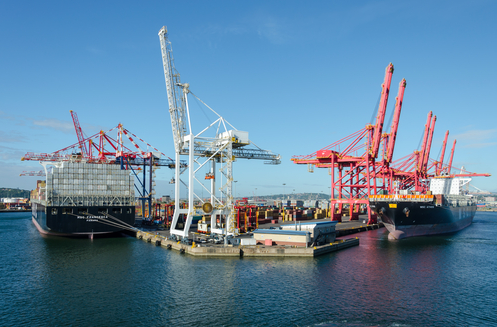The port of Durban operates on a common user basis and consists of five business units managed by Transnet Port Terminals or TPT [formerly known as SA Port Operations (SAPO)] – Durban Container Terminal (Africa’s busiest), consisting of Pier 1 Container Terminal and the main Durban Container Terminal on Pier 2. The Durban Ro-Ro Terminal handles roll-on, roll off traffic (automotive) in addition to breakbulk cargo and a certain amount of containers. There is also a multi purpose terminal at Maydon Wharf, known as the Maydon Wharf Terminal which also handles containers.
There are a number of other terminals in the port which are managed and operated by private companies, including the Bluff Coaling Terminal known as Bulk Connections, the large Island View oil and petroleum complex, often referred to as the Cutler Complex or simply as Island View, the Fresh Produce Terminal at the T-Jetty and another fruit terminal at Maydon Wharf, the Sugar Terminal and Wood Chip Terminal on Maydon Wharf, SA Bulk Terminals (Rennies) on both Maydon Wharf and Island View in addition to a number of other private facilities mostly at Maydon Wharf.
The port has a well-equipped passenger terminal at N-berth on the T-Jetty for the convenience of cruise ships, which operate mostly during the summer months between November and May.
During the summer each year MSC Cruises bases a cruise ship for all-summer cruising at Durban, operating to the Mozambique and Indian Ocean island destinations. The ‘resident’ cruise ship during the 2013/2014 season is the MSC OPERA, with MSC SINFONIA operating some of the longer cruises to destinations like Madagascar and Mauritius.
These and other cruise ships make use of one or more berths as required and at times the port can have as many as three cruise ships in port together. Long-term plans foresee a new cruise terminal being built at A berth on the Point, near the Point Waterfront.
The port has extensive ship repair facilities consisting of a graving dock divided into two compartments with a total length of 352.04m and a width of 33.52m at the top. This splits the dock into an inner dock of 138.68m and an outer dock of 206.9m and serviced by up to five electric cranes from 50t to 10t. Not all the cranes are in use or serviceable. Emptying time for the graving dock is 4 hours.
There are proposals to build a private dry dock at the Dormac Marine shipyard.as required . In addition to the above mentioned the port of Durban has three floating docks – one operated by Transnet NPA with an overall length of 109m, a width of 23.34m and a displaced lifting capacity of 4,500 tonnes, serviced by two 5-tonne capacity cranes is currently not in service.
The second floating dock, known as Eldock, is operated by Messrs Elgin Brown & Hamer and is currently the only privately owned floating dock in South Africa (Elgin operates two similar floating docks at Walvis Bay, known as Namdock 1 and Namdock 2, with a third to follow in 2013). Eldock has a length of 155m, a width of 23.5m and a lifting capacity of 8,500t.
The third Durban floating dock is a smaller unit of 50m length which is used as a launch vessel for tugs and other small vessels built at SA Shipyards and is also licensed for ship repair. Dormac Marine has applied for permission to introduce a fourth and much larger floating dock.
Bayhead has two general repair quays in addition to several privately operated and fully equipped repair quays. Two bunkering companies – Smit Amandla and Unical provide bunker barging services with modern double-hulled barges but no bunkers are served outside the port.
Durban has three marinas for yachting purposes – the main marina opposite the Esplanade, catered for by the Point Yacht Club and Royal Natal Yacht Club, Wilson’s Wharf marina further along the Esplanade which is used predominantly by motor craft, and the Bluff Yacht Club facility in the Silt Canal near Bayhead. The Silt Canal also houses a number of other marine activity clubs. A new marina is envisaged for the area immediately outside the harbour entrance (between the North Pier and Vetch’s Pier) and has recently received approval from an environmental impact assessment and regulatory process.
A large number of other recreational activities take place in Durban Bay including canoeing and kayaking, parasailing, fishing from boats and bird watching at the Heritage Site (mangrove swamps).
Public sight-seeing is available from a variety of ferries and launches operating such services in Durban Bay. These ferries may be located at Wilson’s Wharf, the Durban Marina and at the Gardiner Street Jetty.
The port has a full range of ship chandling and stevedoring operations.
In addition Durban has a interesting Maritime Museum located near the Bat Centre (opposite Aliwal Street) which includes several tugs, a minesweeper and other large and small exhibits.
The main hall houses an interesting photograhic record of the development of Durban Harbour, in addition to many other exhibits including a display covering the whaling history. There is a small charge for entry into the museum.
Copyright Ships & Ports Ltd. Permission to use quotations from this article is granted subject to appropriate credit given to www.shipsandports.com.ng as the source.
